BACK TO STORIES
Quilt Treasures Presents: Virginia Avery
Port Chester; New York; United States
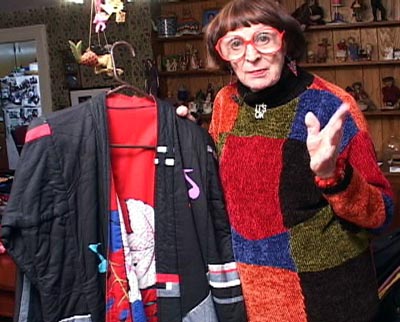
Jinny with one of her coats.
Jinny shows some jackets and coats, including "Don't Shoot the Piano Player She's Doing the Best She Can" and "Hot Time in the Old Town Tonight."
Q: On first sewing experience?
Q: On first quilt?
Q: On learning embroidery?
Q: On starting teaching?
Q: On first garment-making classes?
Q: Beginning of quilt revival?
Q: On getting a career in something you love?
Q: How did you first meet Florence Peto?
Q: Stories about Florence Peto?
Q: On clothing and jackets?
Q: On Jean Ray Laury's quilt camp?
Q: On friendship and quilting?
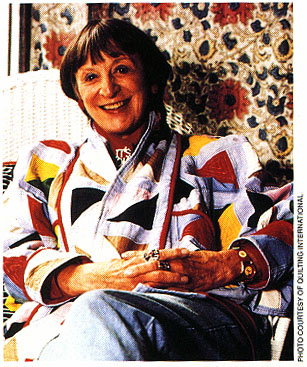
Avery ca. 1998 - from March 1998 issue of Quilters Newsletter Magazine.
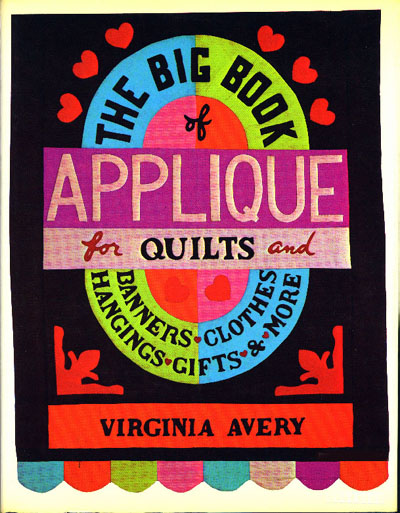
Cover of The Big Book of Applique.
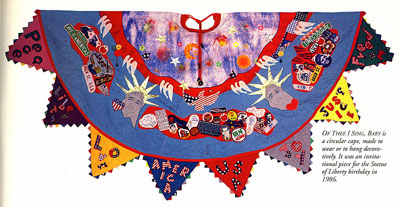
"Of Thee I Sing Baby." Circular cape made as an invitational piece for the birthday of the Statue of Liberty, sponsored by the Museum of American Folk Art in New York City, 1986 - from March 1998 issue of Quilters Newsletter Magazine.
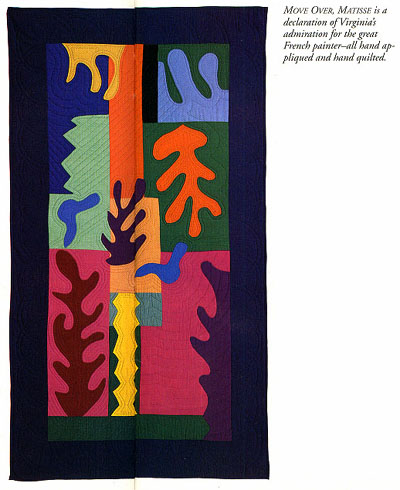
"Move Over Matisse" - from the March 1998 issue of Quilters Newsletter Magazine.
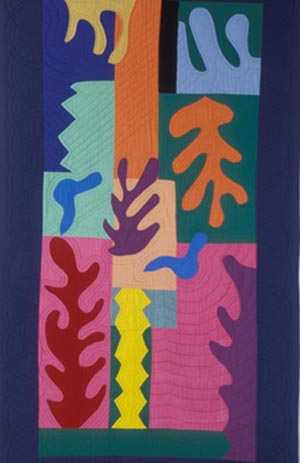
"Move Over Matisse I" (full view) by Virginia Avery, early 1980, 36" x 70". Photo by Charles R. Lynch. Copyright Museum of the American Quilters' Society.
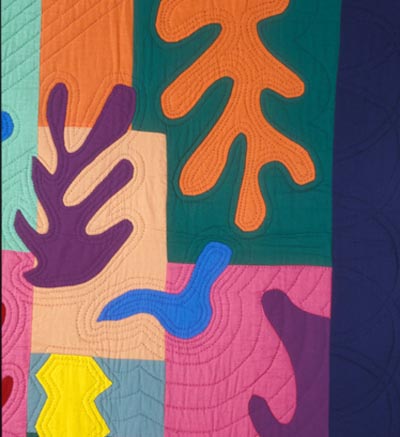
"Move Over Matisse I"; (detail) by Virginia Avery, early 1980, 36" x 70". Photo by Charles R. Lynch. Copyright Museum of the American Quilters' Society.
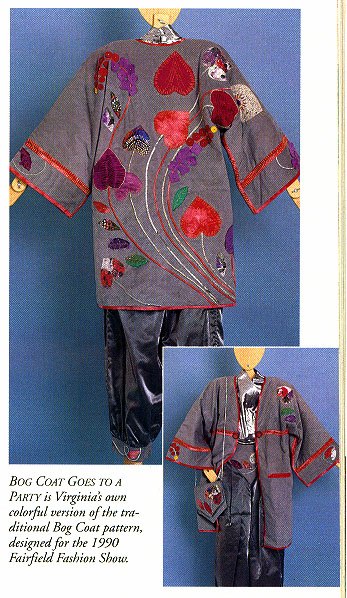
"Bog Coat Goes to a Party." 1990 Made for the 1990 Fairfield Fashion Show - from the March 1998 issue of Quilters Newsletter Magazine.
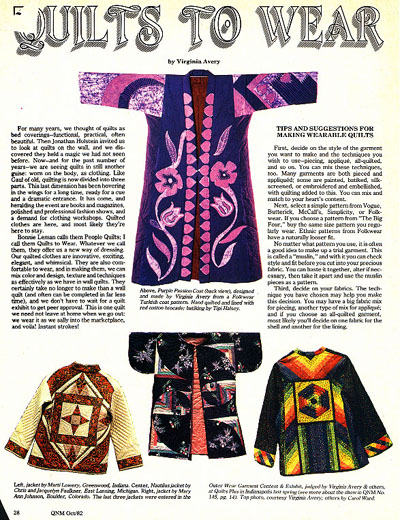
"Quilts to Wear" article from October 1982 issue of Quilters Newsletter Magazine.
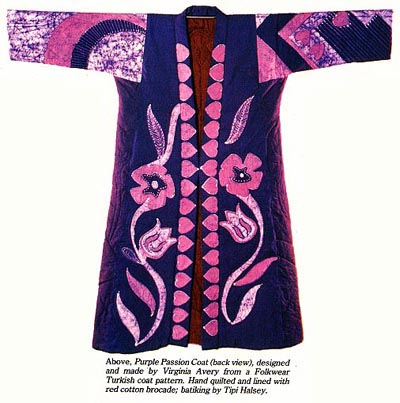
"Purple Passion Coat" - from October 1982 issue of Quilters Newsletter Magazine.

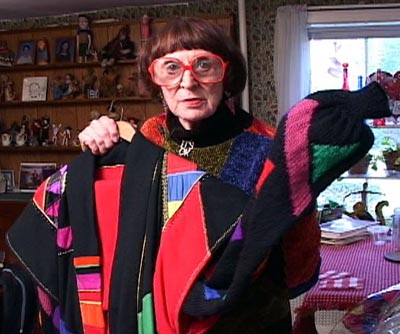
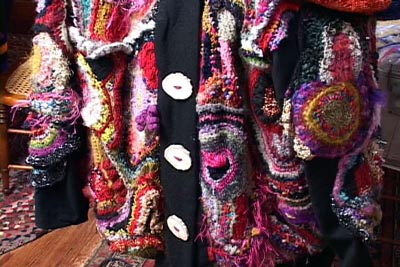
Detail of "Amoeba Jacket."
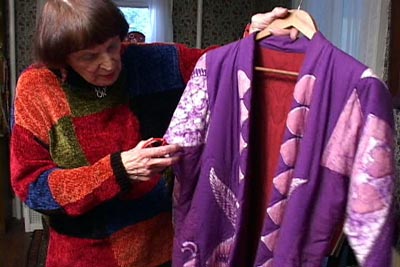
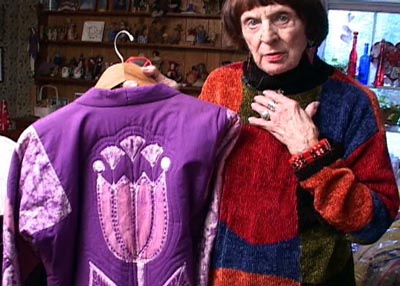
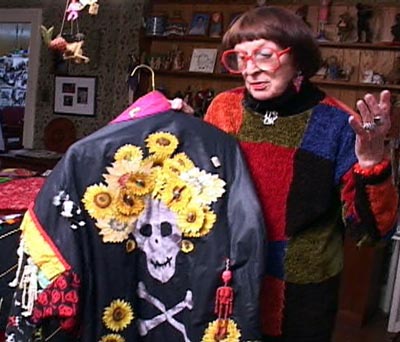
A jacket celebrating the Days of the Dead as they are observed in Mexico.
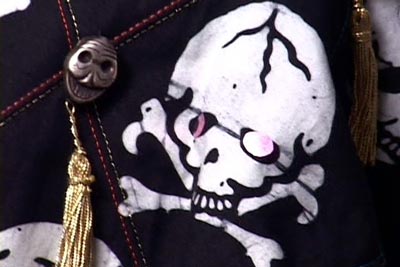
Detail of a jacket celebrating the Days of the Dea as they are observed in Mexico.

"Months of My Years." Hand appliqued and hand quilted, each block has the same landscape shapes, but colors and details are different in each to portray separate months.
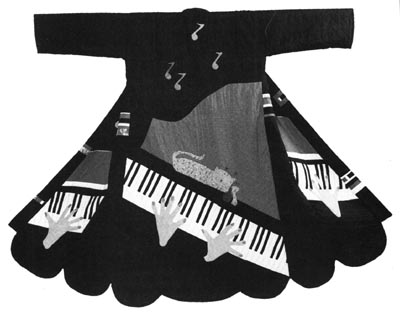
Black and white photo of Avery's well-known jacket, "Don't Shoot the Piano Player, She's Doing the Best She Can."
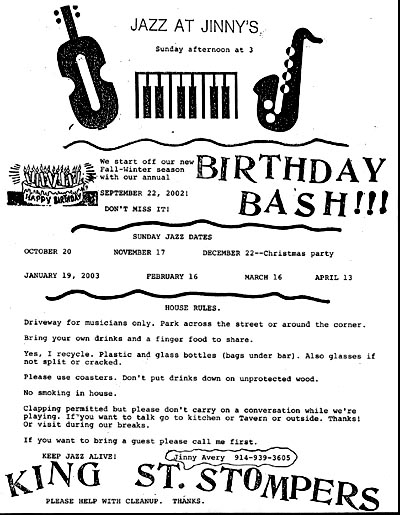
In addition to her extraordinary quilt artistry, Jinny is a jazz pianist. This flyer is from her monthly jazz jam sessions with the "King Street Stompers." She blended these two loves in one of her well-known jackets titled: "Don't Shoot the Piano Player, She's Doing the Best She Can."
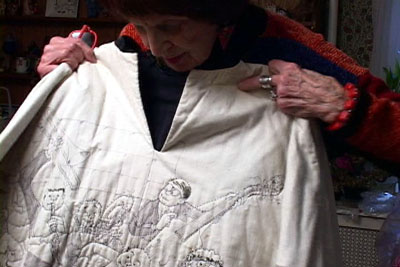
"King St. Stompers Cape." Quilted by Avery following drawings by Pete Wells, a well-known cartoonist and baritone sax player in Avery's band, the King St. Stompers. Drawings are from a photograph of band members.
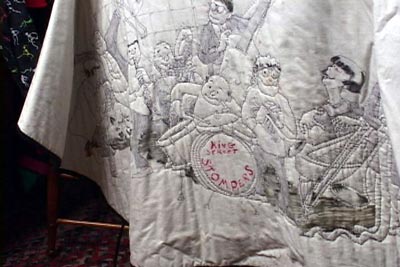
"King St. Stompers Cape." Quilted by Avery following drawings by Pete Wells, a well-known cartoonist and baritone sax player in Avery's band, the King St. Stompers. Drawings are from a photograph of band members.
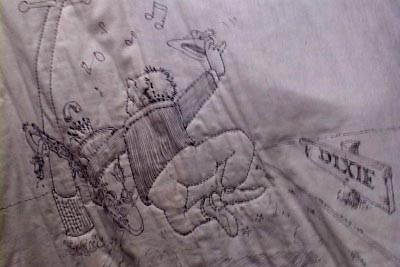
"King St. Stompers Cape." Quilted by Avery following drawings by Pete Wells, a well-known cartoonist and baritone sax player in Avery's band, the King St. Stompers. Drawings are from a photograph of band members.
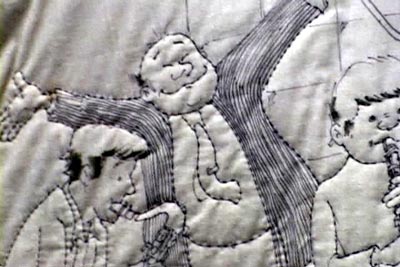
"King St. Stompers Cape." Quilted by Avery following drawings by Pete Wells, a well-known cartoonist and baritone sax player in Avery's band, the King St. Stompers. Drawings are from a photograph of band members.
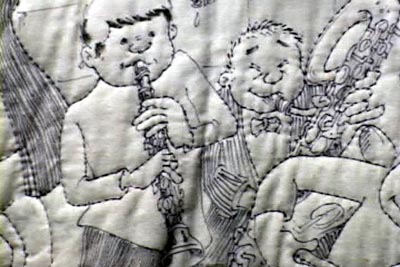
"King St. Stompers Cape." Quilted by Avery following drawings by Pete Wells, a well-known cartoonist and baritone sax player in Avery's band, the King St. Stompers. Drawings are from a photograph of band members.
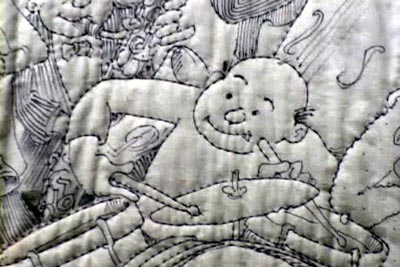
"King St. Stompers Cape." Quilted by Avery following drawings by Pete Wells, a well-known cartoonist and baritone sax player in Avery's band, the King St. Stompers. Drawings are from a photograph of band members.
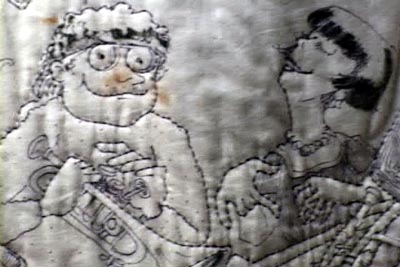
"King St. Stompers Cape." Quilted by Avery following drawings by Pete Wells, a well-known cartoonist and baritone sax player in Avery's band, the King St. Stompers. Drawings are from a photograph of band members.
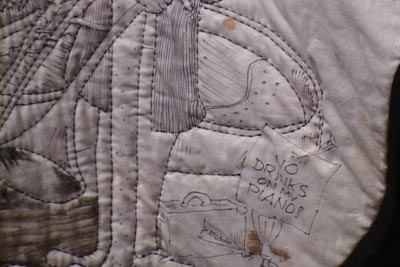
"King St. Stompers Cape." Quilted by Avery following drawings by Pete Wells, a well-known cartoonist and baritone sax player in Avery's band, the King St. Stompers. Drawings are from a photograph of band members.
Timeline
| Born, raised in Greenwood, Indiana | |
| Ages 6-7. Began sewing on mother's treadle sewing machine. | |
| Graduated from DePauw University | |
| Worked at the Indianapolis News | |
| Married | |
| Moved to New York | |
| Had four children | |
| ca. 1960 | Met and befriended Florence Peto at a needlework show sponsored by McCalls in New York. |
| ca. 1960s | Began teaching sewing |
| ca. 1960s | Taught at The Rag Doll in Darien, Connecticut. |
| ca. 1960s | Taught sewing at The Needle House in Chappaqua, New York. |
| ca. mid-1960s | Became interested in quilting |
| Wrote articles of Ladies Circle Patchwork Quilts | |
| 1976 | Attended the Finger Lakes Bicentennial quilt conference in Ithaca, New York. Here she met Jean Ray Laury, Beth and Jeff Gutcheon, Bonnie Leman, and Michael James. |
| 1978 | Published the Big Book of Applique |
| 1979 | Met Joyce Gross |
| ca. 1980 | Began writing articles for Quilter's Newsletter Magazine. |
| 1982 | Published Quilts to Wear |
| 1990 | Wrote lead essay for catalogue of the Definitive Contemporary American Quilt and was also in the exhibit mounted by Bernice Steinbaum Gallery of New York City. |
| ca. 1990s | Named one of the 1000 most influential women of the 1990s by Mirabella magazine. |
| 1991 | Published Wonderful Wearables: A Celebration of Creative Clothing |
| 1995 | Published Hats: A Heady Affair and Nifty Neckwear |
| 1996 | Silver Star Award |
Biography
Virginia Avery has been a professional in the quilt world since the late 1960s, and a pioneer in teaching, lecturing, and judging for quilt guilds and conferences throughout the United States and abroad. Entirely self taught, she has produced an award-winning body of work in both quilts and wearable art, and is well represented in publications and in both private and public collections. She is internationally known as a leader in the wearable art movement, and her creative clothing designs are at once unique and inspirational.
In her workshops, Virginia is noted for her warmth and wit; she shares enthusiasm and information without reservation. Her perception of individual creative needs insures an enthusiastic response from all her students.
She is the author of five books, The Big Book of Appliqué, Quilts to Wear, Wonderful Wearables: A Celebration of Creative Clothing, Hats: A Heady Affair, and Nifty Neckwear. She also writes for many quilt and needlework publications.
Virginia received the Distinguished Alumnus Award from her alma mater, DePauw University; she was listed by Mirabella magazine as one of the thousand most influential women of the 90s, and was also featured in 88 Leaders of the Quilt World, published by Nihon Vogue of Tokyo. She was the third recipient of the prestigious Silver Star Award, presented to her at the International Quilt Festival in Houston for lifetime achievement.
In addition to her career in the quilt world, Virginia is very involved in jazz; she plays piano in a traditional jazz band, The King Street Stompers. In addition to their regular weekly gig, they have appeared on the Today Show and played for the delegates of the United Nations. Virginia feels strongly that jazz and quilting are sisters under the skin, for in both you are always improvising on a theme. Biography written by:
Marsha MacDowell
Mary Worrall
Bibliography
Books by Virginia Avery
Artist's Statement
By: Virginia Avery
My obsession with fabrics has been lifelong. From the first doll clothes I made when I was five, the passion for fabrics has never abated. We used to call them "materials" - we went to a shop or store to buy "material." Whatever happened to that word?
Color is of foremost importance to me; I am continually fascinated by the interaction of color, since we rarely see it in isolation. My interest was fed by years of sewing for myself, then teaching sewing and tailoring in fabric shops until I entered the quilt world in the late 1960s. I knew at once this was my new career, one that would satisfy every aspect of art and creativity. I teach many classes on quilt-making, especially art quilts, but my love, my passion is wearable art. These two, quilts and clothing, are sisters under the skin. We use the same fabrics, the same techniques, many of the same designs, and embellishments, but the difference lies in the final form. A quilt is seen either on the bed or the wall, but clothes have an extra dimension, that of motion. They need to be seen on the human body to bring them to life.
Our lives, and especially our lives as women, are entwined with fabric. We furnish our homes, our cars, our offices with fabric of choice; we clothe ourselves with it whether sleeping or waking. Our clothes also serve as a major force of communication, telling the world how we feel about ourselves and holding the key to our personalities and character.
I have a free-wheeling approach to design for both quilts and clothes, for I prefer to work directly with fabric without using sketches. I want to see the colors interact, and hear what the fabrics say; when I don’t listen, I regret it. Humor and whimsy are both important to me, but I am equally challenged with sophistication and simple elegance. Although most of my work is by machine, I love to add handwork in stitchery, beading and embroidery. I find inspiration everywhere, but jazz and other music is a major source. I play piano for eight men in a traditional jazz band; in jazz and sewing both, we are always improvising. Both have healing qualities too, and together they release my creative spirit and bring an excitement and balance to my life I otherwise might not have.
My major talent in teaching lies in being able to inspire my students, to help them in an affirmative climate to have confidence in their own talents and creativity. With my help they are free to experiment, innovate, and break or surpass boundaries, and the confidence they acquire in my classes is easily transferred to other aspects of daily living. All people are creative, and this need must be expressed and recognized in order to lead a full and expressive life.
Testimony
The Jinny Avery I Know
About ten years ago I took the train from New York City to Port Chester, NY on Long Island Sound, nearly to Connecticut. Jinny lives in a 19th century farm house, now surrounded by city dwellings. The floors are a bit uneven and the stairs are steep but the house has many treasures. Boxes that line the stairs contain items for workshops past and future. The organized clutter adds to the charm of the furnishings.
We spent the afternoon in the kitchen where Jinny prepared delicious food for our dinner while putting a variety of homemade goodies into a number of large, colorful gift bags destined for friends and neighbors. It was almost Christmas. We talked about our past. We had each grown up in the mid-west, she in Indiana, I in Illinois. We lived through WW II, married young had four children, learned to sew at an early age, preferred our nicknames to our given names, liked to cook, preferred to make our gifts, and were serious about our church affiliations. The similarities seemed endless.
Besides cooking and sewing, Jinny is a fine jazz pianist. For over fifty years she has had a gathering of jazz musicians jamming at her house the first Sunday of each month when she is in town. The first night I was there we went to an elegant party in Rye to benefit a local shelter. Jinny played jazz. Next day we were to have morning coffee with our friends Bob and Ardis James in Chappaqua but an overnight snowfall and uncertain road conditions changed the plan. We spent the day in the studio, kitchen, and attic, had more good food.
We talked about Florence Peto and the impact of her life on today's quilt world. I was then writing and lecturing about Peto and wondered if any slides of her work were available. Jinny reached to a high shelf above the pile of fabric and sewing supplies to put a packet of slides in my hand! I had not known that she and Florence were close friends and met monthly in NYC during the 50s and 60s. She showed me framed crewelwork panels Florence had made.
The studio was stacked high with all the necessities for a fabric artist. Orderly chaos. Jinny was working on a vest for her granddaughter's present and other projects were in sight. Jinny has a love of bold, bright colors and uses them to great success in her work. With years of experience she is sure and quick in planning and executing a design and the results is always smashing. I am sure her enthusiasm guarantees success in her classes.
Jinny has abundant energy but she paces herself and takes time out for a nap when needed. Then her vivacity is restored.
The snow ceased during the day and we made our way over the icy streets to attend church the next morning. Soon after returning to the house, the jazz players began to appear, some with wives, bearing refreshments and instruments. When Jinny sat down at the piano, it was the signal to begin....and the band began to swing.
I had had a wonderful weekend and had seen a side of Jinny that many quilters are not able to enjoy. She is warm and open, both serious and humorous, talented but modest, and generous in sharing with and caring about others.
That is the Jinny Avery I know.
Credits
Justine Richardson, MATRIX - project director, videographer, and web portrait co-curator
Marsha MacDowell, MSU Museum - web portrait curator and interviewer
Mary Worrall, MSU Museum - assistant project curator
Website design and production: Addie Guzman, MATRIX
Video editing: Simon Perazza, MATRIX
Project archiving: Rebecca Clark, MSU Museum
Image scanning: Pearl Wong, MSU Museum
Interview transcription: Francie Freese, MSU Museum
Those who contributed questions for this interview:
Joyce Gross
Bets Ramsey
Special thanks to the Museum of the American Quilters' Society for providing photographs of Jinny and Move Over Matisse I.
This Quilt Treasures interview was made possible by generous donations to The Alliance for American Quilts from Jinny Beyer (http://www.jinnybeyer.com) and from Lake Mills Studios. Completion of the web portrait was made possible by significant contributions to The Alliance from RJR Fashion Fabrics in honor of Judy Sabanek and from Karey Patterson Bresenhan and Nancy O'Bryant Puentes in loving memory of their mother and aunt, Jewel Pearce Patterson.
The project was completed with additional in-kind support from Michigan State University Museum and MATRIX: Center for Humane Arts, Letters and Social Sciences Online at MSU.
Written by MacDowell, Marsha;Richardson, Justine (2002)
Quilt Treasures
-
1980
Move Over Matisse... Avery, Virginia
-
Collection
Quilt Treasures
Worrall, Mary
Load More